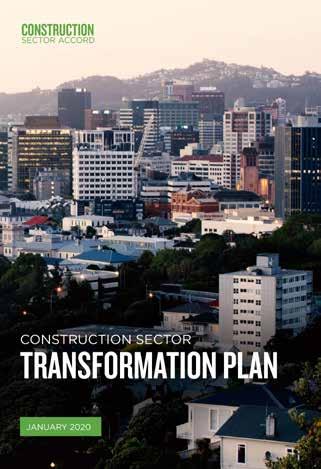
8 minute read
Construction transformation
With the release of the government’s Construction Sector Transformation Plan at the start of the year, NZ Plumber delves into the detail to find out what’s being promised and how it was shaping up before the COVID-19 pandemic forced other priorities for the sector.
CONSTRUCTION TRANSFORMATION: WHAT’S THE PROMISE?

AUTHOR: SARAH JOHNSON
T
he Construction Sector Transformation Plan was launched on 26 January 2020, with six workstreams designed to transform building and construction into a high-performing sector.
The plan is the first of the government’s Industry Transformation Plans, aimed at boosting productivity in key areas and preparing sector workforces for the future. It comes out of the Construction Sector Accord and is a joint government and industry initiative.
Launching the plan, Minister for Building and Construction Jenny Salesa described it as a blueprint for sorting out the construction sector’s long-term challenges around risk, overly complex contracts, skills development and other issues.
“The action plan ensures industry has the right skills, the right people, and the right internal coordination to lift its productivity and take advantage of the quarter of a trillion dollars of public and private construction work expected over the next five years,” she said.
Since the COVID-19 lockdown that started on 25 March, the priority for the Accord Steering Group has been to work closely with the government and relevant agencies to advise on the support and information the construction sector needs. However, the action plan remains in place for when business returns to normal.
Six workstreams Actions in the plan focus on six key workstreams: 1 Leadership – build effective cross-government and industry leadership, share success stories and lessons learned, and provide a coordinated voice on reforms 2 Business performance – lift performance by providing a clearer pipeline of pending work, and sharing good business and risk management practice 3 People development – build capability by addressing skills gaps, shaping reforms in vocational education, and creating a long-term workforce plan 4 Health, safety and wellbeing – reduce the number of workplace accidents, create a more supportive work environment, and improve the sector’s health and safety culture 5 Regulatory environment – improve the building consenting system, and provide leadership to shape and drive legislative reform 6 Procurement and risk – build procurement skills, promote clearer contracts and provide a better deal for subcontractors.
“A great start” Graham Burke, President of the Specialist Trade Contractors Federation and Chair of the Construction Industry Council, was heavily involved in developing both the accord and the plan. He is now joint-lead in the people
GREG WALLACE CEO, Master Plumbers
development workstream and sees the plan as a once-in-a-lifetime opportunity for the construction sector.
“The accord came out of particular failures and stresses in the construction industry. People have realised that the race to the bottom— where the lowest priced tender gets the job—is undermining not only the quality and service life of buildings, but the sustainability of the sector. Our members were screaming out for something to be done.”
Graham doesn’t think the plan is the whole answer, but is a great start, and having the government’s backing, as both the industry regulator and its biggest customer, makes it an exciting opportunity. He says individual construction businesses must play their part as well.
“One of the accord principles is being bold. What this means for our members is not cutting your margins too fine, knowing the risks you face and that the main contractors you work for have a good track record and can pay. Above all, it’s about doing a good job—putting value over cost is what we are pushing for,” he says.
“We will urgently need action” Master Plumbers Chief Executive Greg Wallace agrees that the plan is promising but says that, once business returns to normal, what will urgently be needed is action.

Building and Construction Minister Jenny Salesa describes the 48-page Construction Sector Transformation Plan as a blueprint for sorting out the construction sector’s long-term challenges.
TRANSFORMATION ACTION TIMELINE Prior to the COVID-19 lockdown situation, the Construction Sector Transformation Plan set out three time horizons for implementation of the plan—to June 2020, June 2021 and June 2022.
Workstream 1. LEADERSHIP
2. BUSINESS PERFORMANCE
Beacon projects
Sector culture change
Major reform engagement model Enhanced construction pipeline
Promote better business practice Education programme on commercial risks Build workforce capability
Shape the Reform of Vocational Education Long-term workforce plan
Boost Construction Skills Action Plan Diversity in construction
4. HEALTH, SAFETY & WELLBEING
Health & safety programmes Mental health initiatives
5. REGULATORY ENVIRONMENT
Standard prequalification system New building consenting model
June 2020 Accord leadership group set up & driving transformation Beacon project good practice shared with sector Sector change management plan in place & supporting transformation
Monitoring & feedback process for pipeline implemented
Good business practice information released & promoted Commercial risk management training piloted & rolling out
RoVE engagement underway
June 2021
Engagement model on reform agreed & underway Supply & demand pipeline published. Private sector projects included in pipeline (if feasible)
Pilots for new skills building initiatives completed & rolling out
Industry support for Construction Skills Action Plan underway
Client health & safety leadership training developed & rolling out Mental health strategy in place. Mates in Construction pilot completed & expanding Diversity campaigns underway, including promoting women and youth into construction ‘Safety in design’ principles shared & promoted
Standardised prequalification framework live New model for building consenting developed for consultation
June 2022
Long-term workforce plan in place
Support building legislative reform Ongoing industry input & support for building legislative reform in place 6. PROCUREMENT & RISK Agree & adopt good procurement practices Leadership programme for construction procurers launched & rolling out Construction Procurement Guidelines refined & promoted Fair & transparent contracts Standard risk allocation framework for contracts developed & shared Standard contract principles promoted Subcontractor assurance— contracts, payments & risk Subcontractor assurance initiatives in place Procurement advisory panel Procurement advisory panel in place Acknowledgement: This timeline is taken from pages 42 and 43 of the Construction Sector Transformation Plan, available at constructionaccord.nz/transformation-plan/about





This diagram from the transformation plan document shows the hierarchy and aims of the plan.
THE ACCORD AIMS TO
› Increase productivity › Raise capability › Improve resilience › Restore confidence, pride and reputation
PRIORITY WORKSTREAMS ARE
› Leadership › Health, Safety and
Wellbeing › Business Performance › Regulatory Environment › People Development › Procurement and Risk
ACTIONS ARE FOCUSED ON
› Leadership group to oversee the plan › Industry leadership voice on reforms › Building skills and diversity › Health, safety and wellbeing programmes › Fairer and more transparent contracts › Sharing good practice › Improving consenting processes › A comprehensive and certain pipeline
“We fully support the thinking behind the accord and the plan, but we will need to see some small wins on the board. Our members have to feel confident that action is happening, and that there is a tangible pathway for how the accord and plan will deliver benefits for the industry,” says Greg.
Greg identifies a handful of improvements—such as lifetime procurement for government contracts, compulsory apprenticeships within companies working on government jobs, and reforms to the Construction Contracts Act 2002—that could be achieved relatively quickly and would deliver real benefits for members. But he considers that action to date has been slow.
“We still have a situation where subcontractors are working on government-funded jobs and being left in the lurch, through failure of the main contractor. This shouldn’t be happening on government contracts, and is
something we will be looking to the plan to address, and quickly,” he says.
Programme delivery Work is underway in all of the plan’s workstreams, with programmes due to be delivered over three timeframes.
In the people development workstream, Graham is busy with the Reform of Vocational Education (RoVE) programme, including gathering expressions of interest to set up a Centre of Vocational Excellence for the construction and infrastructure industries. The centre will focus on making step-change improvements to construction-related vocational education to help fix the industry’s long-standing skills challenges.
BUY A NEW HITACHI MINI EXCAVATOr THIS SEASON

AND SCORE a hIKOKI POWER TOOL KIT ON US! *


2-PIECE KIT

4-PIECE KIT 6-PIECE KIT
WITH
ZX17U-5 / ZX26U-5 EXCAVATORS PURCHASED

WITH
ZX33U-5 / ZX38U-5 EXCAVATORS PURCHASED

WITH
ZX55U-5 / ZX65U-5 EXCAVATORS PURCHASED
Hitachi’s mini excavators have a reputation for being incredibly reliable, stable and light weight construction machines, ideal for tight narrow places, where the big machines can’t go. With user-friendliness at the heart of every Zaxis mini excavator design, smaller models are easily transported by trailer and convenient maintenance features make them quick to clean and inspect. With a comfortable cab and smooth, efficient hydraulics, our mini excavators make a big impression on the job site.









